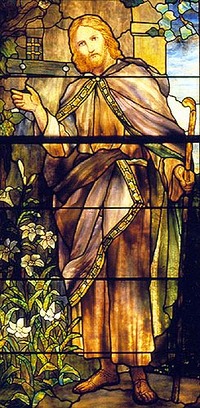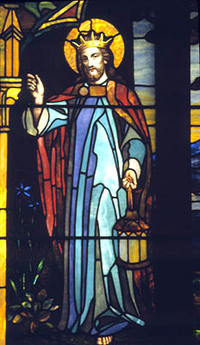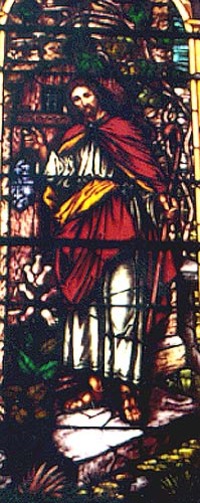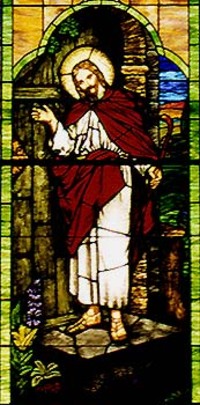MSGC : Featured Windows : Current Window
Featured Windows, November 2004
"The Light of the World"
Buildings:
Trinity Episcopal Church - Grand Ledge, Michigan
First Reformed Church of Zeeland - Zeeland, Michigan
First Congregational Church - Union City, Michigan
First (Park) Congregational Church - Grand Rapids, Michigan
Descriptions of windows with the theme "Light of the World"
Here in Michigan, as in many other places, several familiar iconographic images are repeatedly found in stained glass windows. A few of these examples include Christ knocking at a door, Christ kneeling on a rock, Christ holding a lamb, Christ with a group of children, and the boy Jesus in his father's carpenter shop. The sources for many of these images were 19th century paintings by German artists such as Heinrich Hoffman (1824-1902)(Christ in the Garden of Gethsemene) and Bernhard Plockhorst (1825-1907) (The Good Shepherd and Jesus with the Little Children).
Left: First (Park Congregational Church, Grand Rapids, MI, Tiffany Studios, New York (1905), MSGC 93.0009.
Right: Trinity Episcopal Church, Grand Ledge, MI, John J. Kinsella Co., Chicago, IL (c1913), MSGC 92.0051.
Another often repeated image in stained glass (Christ knocking at a door)is reportedly based on William Holman Hunt's(1827-1910) painting
The Light of the World. New research shows Hunt was most likely influenced by others before him whose work heretofore has not been widely acknowledged by art historians. The Michigan Stained Glass Census has documented quite a few windows of "The Light of the World."
Left: First Congregational Church, Union City, MI, Flanagan & Biedenweg Co., Chicago, IL (1918), MSGC 01.0008.
Right: First Reformed Church of Zeeland, Zeeland, MI, Grand Rapids Art Glass, Grand Rapids, MI (1929), MSGC 00.0049.
Timeline for relevant events:
- Biblical passage from Revelation 3:20. "Behold, I stand at the door, and knock: if any man hear my voice, and open the door, I will come in to him, and will sup with him, and he with me."
- 1765: Joseph Grigg's poem (ca 1720-1768) "Behold, a Stranger at the door! He gently knocks, has knocked before…"
- Circa 1815: Johann Friedrich Overbeck (ca 1789-1869) was overtaken by religious fervor at age 18 while enrolled in the Vienna Academy of Fine Arts, and shortly thereafter moved to Rome with three like-minded friends. They organized a community of painters called the Nazarenes, who were caught up in a romantic reverence for the Middle Ages, wanting to relate "art" to the church by copying the intent of Durer, Raphael and other 16th-century artists. Overbeck had one early painting titled Behold I Stand at the Door and Knock, of which no image seems to exist today. By the latter part of the 18th century and the early part of the 19th century, printing presses, metal engravings and etchings were the means by which it was possible to make earlier works available to more and more people. It was very likely Overbeck had seen Grigg's poem and was moved sufficiently to incorporate its imagery into his work.
- 1824: Philipp Veit (1789-1869) painted Christ Knocking on the Door of the Soul. Literary critic and historian Lionel Gossman has written of the influence the Nazarene Brotherhood had on a later group, the pre-Raphaelite Brotherhood. In 1830 Veit was named the headmaster of the art school and director of the Staedel Art Museum in Frankfurt, Germany, a position he held for many years.
- 1851-53: William Holman Hunt's (1827-1910) well known illustration of Christ knocking at a door, entitled The Light of the World, can be seen at Keble College in Oxford, England,with a smaller, second version now at Manchester Art Gallery, Manchester, England, and a third version completed between 1900 and 1904 now at St. Paul's Cathedral in London. Due to the Victorian popularity of Hunt's paintings, and the publicity that surrounded its trip around the world, many other allegorical paintings and poems were produced in the next fifteen years echoing the sentiments of Christ standing outside the door to the human heart of mankind. Around 1850, as photographic reproductions became available and as cumbersome metal plate engravings became obsolete, it was possible to reproduce and widely disseminate these paintings in bibles, Sunday school books, popular magazines and as bookmarks and postcards. As immigrants came to the United States with their prayer books in hand, the proliferation of images was reinterpreted in the stained glass of their churches.
- 1933: Warner Sallman (1892-1968) trained at the Art Institute of Chicago and became a popular Christian artist when his charcoal and oil depictions of Christ's head were reproduced in small prints in 1941. This was followed by Christ at Heart's Door, Christ in the Garden, and The Lord is My Shepherd, all modern versions of the Hoffman, Plockhorst and Hunt paintings. These works are now in the collection of Anderson University in Anderson, Indiana and large framed reproductions are found in the halls and offices of many churches in the United States.
The pre-Raphaelite Brotherhood was founded in the fall of 1848, with major members including Hunt, John Everett Millais, Dante Gabriel Rossetti, William Morris and Edward Coley Burne-Jones. In his research, art historian Jeremy Maas has found an envelope with an 1851 postmark that bore, on the back, tiny sketches with Christ in several positions and one sketch which showed the nearly complete idea with Christ holding a lantern.
Because Hunt wanted to accentuate the point of the painting as being at night, he decided to have a scale model lantern made and went to the trouble to do much of his initial painting at night in an orchard, to get the correct effect of the moonlight. He also engaged a male model to pose for the figure of Christ, Christina Rossetti to pose for the facial expression and another woman to model for the effect of Christ's hair.
Mr. Coombe, a friend and subsequent client of Hunt's, purchased the completed painting, and upon his death in 1863 his wife gave
The Light of the World to Keble College at Oxford. According to old newspaper clippings, the architect of the Keble College chapel decided the painting was too small to serve as the main feature in the chapel chancel. While the painting was being stored awaiting a final decision as to its placement, it was stored near some hot water pipes and heat from the pipes caused much of the painted surface to shrivel. After considerable rancorous discussions, Hunt repaired the painting, which was 4 '1 " by 1'11", at his own expense and in 1895, after a side chapel was built on the Keble College Chapel with a bequest from Mrs. Coombe, the painting was transferred back to the college chapel.
A gallery subsequently asked to see the painting and was refused, prompting Hunt to begin a second, much smaller version of the painting (about 21"x10"). The record of its ownership is somewhat vague, but apparently someone in New York held ownership at one time. Records show it was sold at one point to Dowager Lady Tweedmouth. In 1912, four years after her death, it was auctioned to the
Manchester Art Gallery, Manchester, England where it still is located.
The third, life-sized version (7'8" x 4'2"), was begun in 1899 around the time Hunt was having problems with his eyesight due to glaucoma and cataracts. There was considerable discussion as to how much of version #3 Hunt painted himself, as it was reported several students were involved with the project, which was finally completed in 1904. Hunt imposed a condition to the sale of the painting, his intention being that it should be presented to the Tate Gallery in London. Thus he sought a benefactor who would agree to these conditions.
Charles Booth and his wife purchased the painting and Booth made arrangements to exhibit it at the Fine Art Society in London. This occurred during March and April of 1904. By January 1905, Booth had made arrangements for the painting to go on a grand world tour and it arrived by ship in Halifax, Nova Scotia by early February. The lumbermen, fishermen, miners and fruit farmers showed a complete lack of interest in the painting, and it was then sent to St. Johns, Newfoundland where apparently for the first time ever, photogravures of any painting were sold.
The painting then traveled to Ottawa, Montreal and Toronto where it received mixed reviews. It went to Winnipeg, the capital of Manitoba, from where it was sent to Regina, Saskatchewan and Vancouver, British Colombia. The trip through Canada was far from the glorious event Booth had hoped for. The highest attendance figure was 400 on one Sunday afternoon in Montreal.
The painting was then shipped back to London. By the time it arrived, Booth had made arrangements for it to travel to Australia and by January 1906 the painting (three crates with one for the painting, one for the frame and one for the glass) arrived to a much different reception than that in Canada. There began what could be called a public frenzy when crowds of people thronged to see
The Light of the World, approximately 17,000 in the first seven days in Adelaide. What caused this reception? Apparently the Australian culture was much more akin to that of old British values than that in Canada, as there was much longing for the ideals of the homeland. The painting was exhibited in Melbourne and Sydney, where it was reported that 15,000 people saw it in one Sunday afternoon, and probably well over 500,000 during the entire tour.
The Light of the World traveled to several stops in New Zealand and, after a total of sixteen months, left the South Pacific for South Africa where it was received with "rapturous delight." After several weeks, it returned to England, where in the meantime, arrangements had been made between Hunt and Booth to present the painting to St. Paul's Cathedral instead of the Tate Gallery. On Friday June 5, 1908 the painting was installed at St. Paul's during an Evensong service.
Two years later Hunt died and his ashes were buried in the crypt of St. Paul's near the graves of other notables such as Sir Christopher Wren, Sir Joshua Reynolds, J.M.W. Turner and his old friend Millais. The painting still hangs in the same place and was not even removed during the Blitz when the Cathedral was damaged.
So ends this story, but postcards, bookmarks, and larger reproductions of the painting are very popular items in the bookstores of Manchester Art Gallery and St. Paul's Cathedral.
Bibliography:
Show Bibliography"Friederich Overbeck," in The Catholic Encyclopedia, Volume I. Copyright © 1907 by Robert Appleton Company. Online Edition Copyright © 2003 by K. Knight. http://www.newadvent.org/cathen/11362a.htm.
Gossman, Lionel. "Unwilling Moderns: The Nazarene Painters of the Nineteenth Century," Nineteenth-Century Art Worldwide 2 (Autumn 2003).
Grigg, Joseph. "Behold a Stranger at the Door" (1765). The Lutheran Hymnal (St. Louis: Concordia Publishing House, 1941).
Harrison, Martin. Victorian Stained Glass. (London: Barrie & Jenkins Ltd., 1980).
Harrison, Martin. Correspondence with author, June 2004.
Hilton, Timothy. The Pre-Raphaelites. (London:Thames and Hudson Ltd., 1970).
Landow, George P. Replete with Meaning: William Holman Hunt and Typological Symbolism. (New Haven: Yale University Press, 1979). http://www.victorianweb.org/painting/whh/replete/contents.html.
Maas, Jeremy. Holman Hunt & The Light of the World. (London and Berkley, CA: Scholar Press, 1984).
"Nazarenes, " in The Columbia Electronic Encyclopedia, 6th ed. Copyright © 2004, Columbia University Press. http://www.infoplease.com/ce6/ent/A0835050.html.
Rev. 3:20. The Holy Bible, King James Version. Blue Letter Bible. 1913. 5 May 2003. 18 Jul. 2004. http://www.blueletterbible.org/kjv/Rev/Rev003.html.
Weis, Helene H. "Familiar Faces," Stained Glass Quarterly. Fall 1991, 204-207.(MSGC 93.0009; 92.0051; 01.0008; 00.0049)
Text by Barbara Krueger, Michigan Stained Glass Census, November , 2004.






